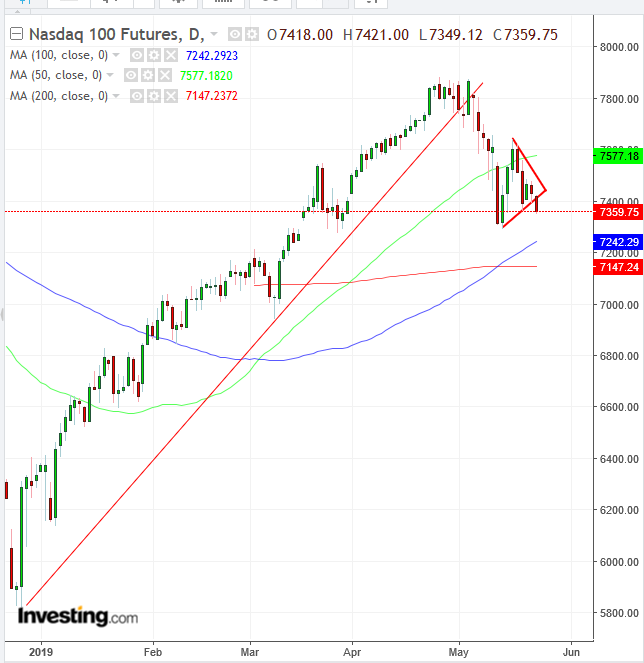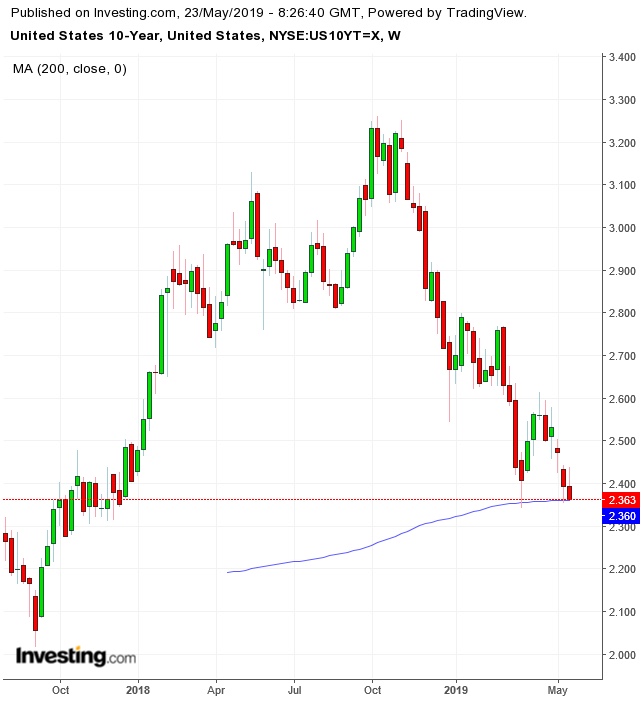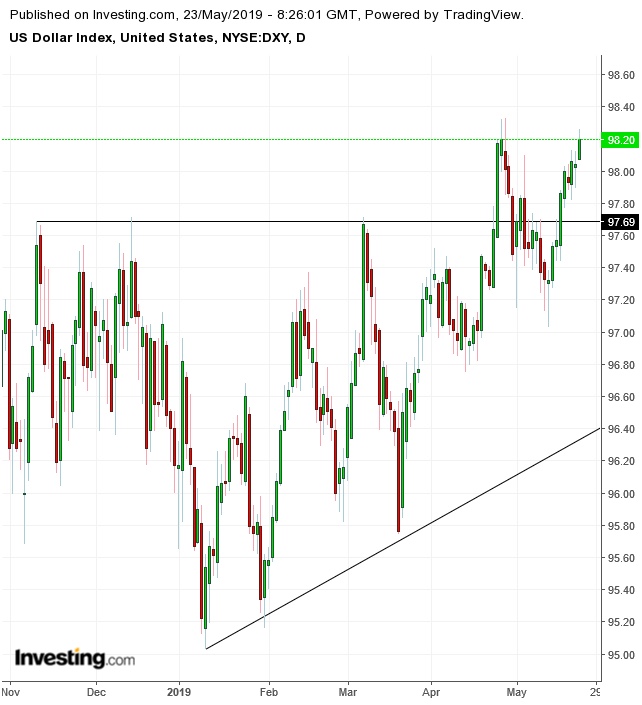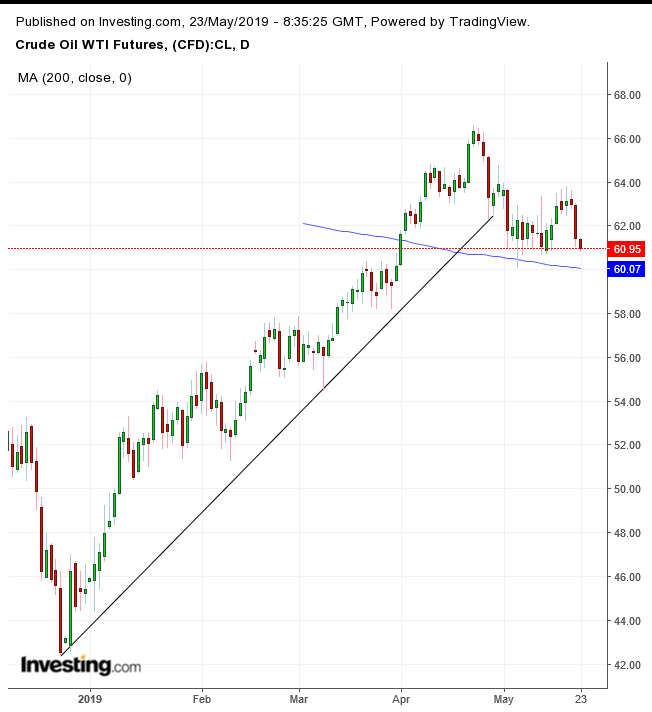- U.S. futures, European shares tumble on amplified trade-related headwinds
- NASDAQ futures set to complete bearish pattern
- Treasury yields drop to lowest levels since Dec. 2017 on Fed minutes' dovishness
- Surprise inventory build threatens to end WTI uptrend
Key Events
Futures on the S&P 500, Dow and NASDAQ 100 all tumbled around 1% or more this morning, deepening yesterday’s selloff as reports of trade-related headwinds multiplied.

NASDAQ futures hovered around 1.37% lower by late European morning following defiant criticism, from China’s Communist Party’s newspaper People’s Daily, of the Trump administration's moves to curb business with Chinese tech companies—as well as on reports that Japanese tech giant Panasonic may join the list of companies halting business with Huawei. Technically, the fact that futures on the tech-heavy index fell below a pennant—a converging trading pattern—signifies a resumption of the prior trend, lower, in this case.
Over to Europe's STOXX 600, downbeat manufacturing PMI figures for the region and business climate reports for Germany re-ignited fears over the economic impact of a never-ending trade war. Automakers contributed to dragging prices on the pan-European benchmark to the lowest level since March 13.
In the earlier Asian session, Chinese stocks on Hong Kong’s Hang Seng (-1.58%) took the brunt of the regional selling, hitting the lowest price since Jan. 24, falling on a gap below the 200 DMA. The mainland Shanghai Composite (-1.36%) slid below the 100 DMA, to the lowest level since May 9, to the bottom of a congestion, potentially completing a bearish, rising flag.
India bucked the trend, with equities soaring as national election results showed Prime Minister Narendra Modi was set to win a majority on his own.
MSCI Asia Pacific Index is now down 6% since U.S. President Donald Trump pledged to ramp up tariffs on China earlier this month.
Global Financial Affairs
U.S. equities dropped on Wednesday on reports the White House was looking to add more Chinese technology firms to its trade blacklist. The price action resumed to develop a trading range mirroring the daily zig zag of trade sentiment. Each of the four U.S. majors has been forming a pennant-shaped congestion, reflecting equal determination among bulls and bears, but with a breakout presumed to be to the downside, resuming the drop since the beginning of the month.
The S&P 500 fell 0.28%. Ironically, with the exception of third-biggest laggard Industrials (-0.82%), trade-related sectors did not lead the slump. Energy (-1.55%) underperformed, tracking oil’s biggest drop in three weeks. The second-worst performing sector was Consumer Discretionary (-1.03%). Looking at the ranking order of the index's 11 sectors, Communication Services (-0.1%) and Technology (-0.52%) fared fifth and seventh: considering they would be the most exposed sectors to the latest Huawei-ban led trade headwinds, yesterday's performance confirms our ongoing argument that the single biggest headwind to equities isn't necessarily trade.
The Dow Jones Industrial Average retrenched 0.39%. It touched the top of its pennant pattern and backed down.
Stocks on the NASDAQ Composite dropped 0.45%, underperforming large caps on other indices.
The Russell 2000 was the heaviest faller, slipping 0.84%. Considering small-cap stocks should outperform during trade uncertainty, there may be some other driver behind their poor results. While some analysts point to the effects of Europe's Mifid II legislation, our best guess is the rising dollar, which exacerbates headwinds for an export-sensitive environment.

Meanwhile, the yield on 10-year Treasurys fell to the lowest level since Dec. 15, 2017 after minutes of the Federal Reserve’s last policy meeting showed officials judged a patient approach to interest-rate changes would be appropriate “for some time.” Notably, the accounts also highlighted doubts, by some FOMC members, that long-term inflation expectations could be below the central bank's 2% target—something that could determine the bank's future rate decisions. Technically, yields found support above the 200 WMA, for now.

The dollar continued to strengthen on its safe-haven status, rising above the April 25 highest close by a single pip to 98.20. Technically, that deepens the upside breakout of an ascending triangle.
The pound extended losses to a third straight day—or for the ninth session out of ten—amid a growing lawmakers' revolt over Brexit that looks increasingly likely to force U.K. Prime Minister Theresa May to resign.
The euro fell to less than 0.5% from the April 25 low, the lowest since June 2017, as voting for the new European parliament got underway.
China’s yuan dipped in onshore trading even after the People’s Bank of China set its daily fixing at a stronger-than-expected level for a fourth straight day. The USD/CNY is pressing against the May 17 high, a gateway to reach the highest price since Nov. 30.
Overall, analysts are disagreeing on the outlook on trade, the biggest headwind to stocks according to the current market narrative. One expert predicts tensions could endure until 2035, while economists are turning more pessimistic. Goldman Sachs now sees higher odds of a stalemate between the two nations, and Nomura has shifted to forecasting a full-blown escalation of tariffs.

Commodities slumped across the board on Wednesday as traders increasingly gear up for an all-out trade war. The strengthening USD is also weighing on prices. Crude oil fell below $61 a barrel after an unexpected build in inventories strengthened supply concerns. Some analysts stressed that the OPEC's latest decision to move its next key summit to the first week of July could impact prices in unforeseen ways. The price has found support, for now, at the month’s lows and the 200 DMA. A slide below the $60 level would signal a reversal, as the price would form a descending peak-trough progression in the same time.
Up Ahead
- On Thursday, the ECB publishes its account of April's monetary policy decision.
- The European Parliament holds continent-wide elections on May 23-26.
Market Moves
Stocks
- The U.K.’s FTSE 100 dropped 0.6%.
- Germany’s DAX declined 1.1%, the lowest in more than a week.
- The MSCI Emerging Market Index fell 1%, the lowest in more than 19 weeks.
- The MSCI Asia Pacific Index lost 0.7%.
Currencies
- The Dollar Index advanced 0.2%.
- The euro slipped 0.1% to $1.1134, the weakest in four weeks on the biggest fall in a week.
- The British pound dropped 0.5% to $1.2607, the weakest in more than five months.
- The Japanese yen climbed 0.2% to 110.18 per dollar, the biggest increase in more than a week.
Bonds
- The yield on 10-year Treasurys slid one basis point to 2.37%, the lowest in eight weeks.
- Germany’s 10-year yield fell two basis points to -0.10%.
- Britain’s 10-year yield declined three basis points to 0.986%, the lowest in more than 20 months.
- Italy’s 10-year yield advanced less than one basis point to 2.637%.
Commodities
- West Texas Intermediate crude dropped 0.8% to $60.92 a barrel, the lowest in almost eight weeks.
- Gold climbed 0.1% to $1,274.63 an ounce, the biggest increase in more than a week.
